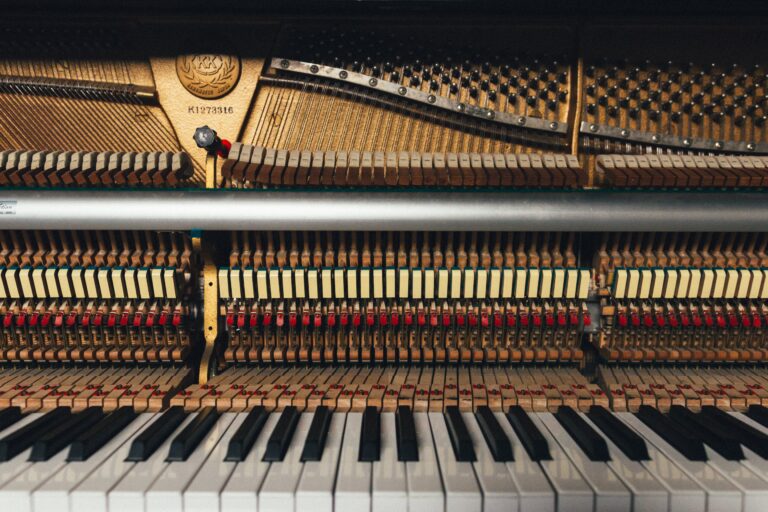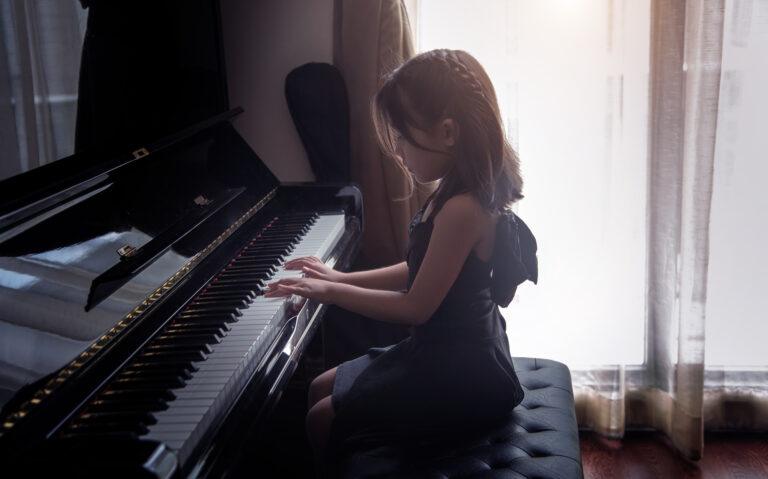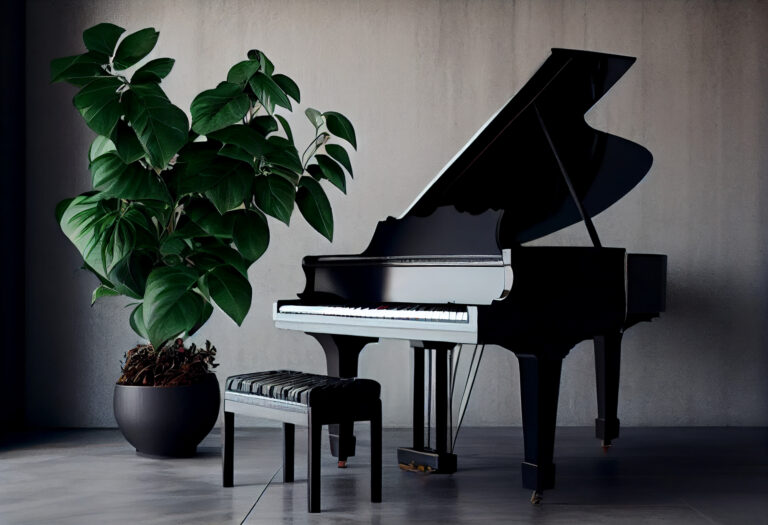Symphonic Synchrony: Mastering the Art of Two-Handed Piano Playing
Learning to play the piano with both hands is an essential skill for any pianist. It can be challenging at first, but with practice and dedication, you can master this technique. Playing with both hands allows you to create a more complex and rich sound, and it opens up a world of possibilities for your piano playing.

To start playing with both hands, you need to understand the basics of piano playing. You should know how to read sheet music and understand the different notes and symbols. You also need to know the correct hand position and finger placement on the keys. Once you have these basics down, you can begin to practice playing with both hands.
It’s important to start with simple pieces and exercises to build up your coordination and dexterity. You can start by playing scales and arpeggios with both hands, then move on to simple songs and pieces. With time and practice, you’ll be able to play more complex pieces with both hands, and you’ll be amazed at the beautiful music you can create.
Understanding the Piano Layout

Playing the piano with both hands can be a daunting task, especially if you are new to the instrument. However, with a good understanding of the piano layout, you can make the process much easier.
The Keyboard
The keyboard is the most important part of the piano. It consists of 88 keys, which are arranged in a specific pattern. The keys are divided into two colours: black and white. The white keys are the natural notes, while the black keys are the sharps and flats.
The Octaves
The keyboard is divided into octaves. An octave is a set of 12 keys that includes seven white keys and five black keys. Each octave starts with a C note and ends with a B note. The notes in an octave are numbered from 1 to 7, starting with the C note.
The Hands
When playing the piano with both hands, it is important to understand the role of each hand. The right hand usually plays the melody, while the left-hand plays the accompaniment. The left hand is responsible for playing the bass notes and chords.
The Fingering
Fingering is an important aspect of playing the piano with both hands. It refers to the use of fingers to play the keys. The fingers are numbered from 1 to 5, starting with the thumb. The right hand usually uses fingers 1 to 5, while the left hand uses fingers 5 to 1.
By understanding the piano layout, you can start playing with both hands and create beautiful music. With practice and patience, you can become a skilled pianist.
Fundamentals of Hand Positioning
When it comes to playing the piano with both hands, proper hand positioning is crucial. Here are the fundamentals of hand positioning that you need to know:
Right-Hand Positioning
To position your right hand correctly, follow these steps:
- Sit at the centre of the piano with your back straight and your feet flat on the ground.
- Place your right hand over the keyboard with your fingers curved and your thumb resting on the middle C.
- Your wrist should be slightly higher than your fingers, and your forearm should be parallel to the floor.
- Keep your fingers close to the keys, but don’t let them rest on them.
Left-Hand Positioning
To position your left hand correctly, follow these steps:
- Sit at the centre of the piano with your back straight and your feet flat on the ground.
- Place your left hand over the keyboard with your fingers curved and your pinky resting on middle C.
- Your wrist should be slightly higher than your fingers, and your forearm should be parallel to the floor.
- Keep your fingers close to the keys, but don’t let them rest on them.
Remember, hand positioning is essential to playing the piano with both hands. Practice these fundamentals until they become second nature, and you’ll be well on your way to becoming a skilled pianist.
Reading Piano Music
Understanding Staff Notation
When reading piano music, it is important to understand staff notation. The staff is composed of five horizontal lines and four spaces. Each line and space represents a note. The lines and spaces are named after the first seven letters of the alphabet: A, B, C, D, E, F, and G.
The notes on the staff can be either in the treble clef or the bass clef. The treble clef is used for higher-pitched notes played with the right hand, while the bass clef is used for lower-pitched notes played with the left hand.
Identifying Notes for Each Hand
To play the piano with both hands, it is necessary to identify the notes for each hand. The notes for the right hand are usually written in the treble clef, while the notes for the left hand are usually written in the bass clef.
To identify the notes for each hand, it is helpful to practice reading music separately for each hand. Start by playing simple melodies with only one hand, then gradually add the other hand. It may take some time to get used to playing with both hands, but with practice, it will become easier.
Remember to keep your hands relaxed and in the correct position while playing. With consistent practice and a good understanding of staff notation, you will be able to play the piano with both hands confidently and skillfully.
Coordinating Hands Together

Playing with both hands is an essential aspect of piano playing. Coordinating both hands together can be challenging, but with consistent practice, it can be mastered. Here are some tips to help you coordinate your hands together.
Simple Melodies and Chords
Begin by practising simple melodies and chords with both hands. Start with a simple melody in the right hand and play the corresponding chords in the left hand. Practice slowly and gradually increase the tempo as you become more comfortable. Once you have mastered playing the melody and chords together, try switching the melody to the left hand and the chords to the right hand.
Developing Hand Independence
Developing hand independence is crucial for playing with both hands. Start by practising exercises that focus on each hand separately. For example, practice playing scales with your left hand while your right-hand plays a simple melody. Then switch hands and practice the same exercise. This will help develop hand independence and coordination.
Another exercise to develop hand independence is to play different rhythms with each hand. For example, play a simple melody with your right hand while your left-hand plays a syncopated rhythm. This exercise will help you develop the ability to play different rhythms with each hand.
Coordinating both hands together is an essential skill for piano playing. With consistent practice and the right techniques, you can master playing with both hands. Remember to start with simple melodies and chords and gradually progress to more complex pieces. Good luck!
Practice Techniques

To improve your ability to play the piano with both hands, you need to practice regularly. Here are some practice techniques that can help you develop synchronization between your hands and gradually increase the complexity of the pieces you can play.
Hand Synchronization Exercises
One effective way to improve your hand synchronization is to practice exercises that require both hands to play different rhythms and melodies simultaneously. One such exercise is to play scales with both hands, starting with a simple pattern and gradually increasing the complexity. Another exercise is to play arpeggios with both hands, focusing on keeping the timing and rhythm consistent between the two hands.
Progressive Complexity in Pieces
Another way to improve your ability to play with both hands is to gradually increase the complexity of the pieces you practice. Start with simple pieces that require only a few notes to be played with both hands and gradually move on to more complex pieces that require more coordination between the hands. As you progress, you can also try playing pieces that require different rhythms and melodies to be played with each hand.
To summarize, practising hand synchronization exercises and gradually increasing the complexity of the pieces you play can help you improve your ability to play the piano with both hands. Remember to practice regularly and be patient with yourself as you work towards your goals.
Advanced Playing Tips
Pedal Usage
When playing with both hands, it is important to use the pedal to create a smooth and connected sound. The pedal is used to sustain notes and blend them, which can make your playing sound more professional and polished.
To use the pedal effectively, you should press it down as you begin to play a new chord or note, and then release it as you move on to the next chord or note. This will create a seamless transition between the notes and help to avoid any awkward gaps or breaks in the sound.
It’s also important to be aware of how much pressure you are applying to the pedal. Too much pressure can cause the notes to become muddy and indistinct, while too little pressure can result in a choppy and disjointed sound. Experiment with different levels of pressure to find the right balance for your playing style.
Dynamic Hand Balancing
Balancing the dynamics of both hands is crucial for achieving a well-rounded and expressive sound. When playing with both hands, it’s important to keep your hands at a similar volume level, so that one hand doesn’t overpower the other.
To achieve this balance, you can practice playing each hand separately, focusing on the dynamics of each hand and making sure they are consistent. You can also try playing with a metronome to help keep your timing and rhythm consistent.
Another technique for balancing the dynamics of both hands is to use a weighted keyboard or weighted keys. This will help you to develop a stronger sense of touch and control, which can make it easier to balance the dynamics of both hands.
By using these advanced playing tips, you can take your piano playing to the next level and achieve a more professional and polished sound. With practice and dedication, you can master the art of playing with both hands and become a skilled and accomplished pianist.






